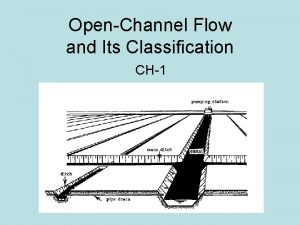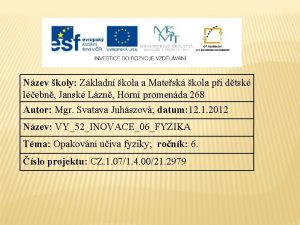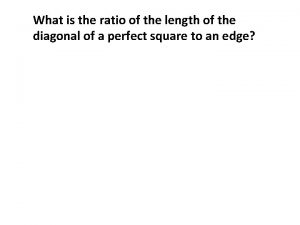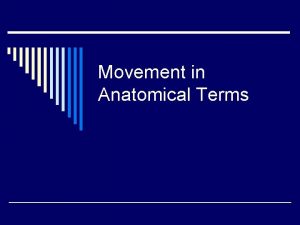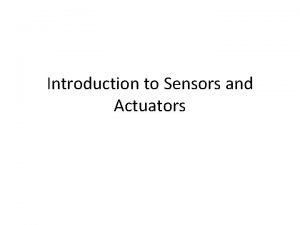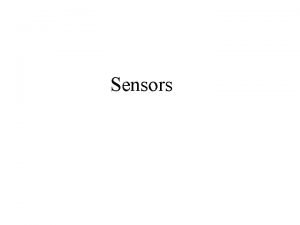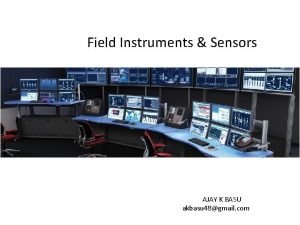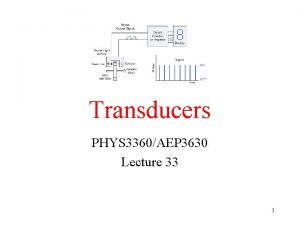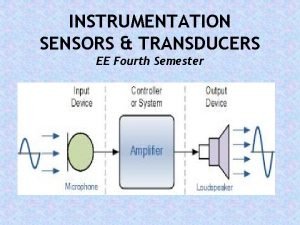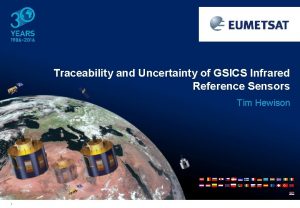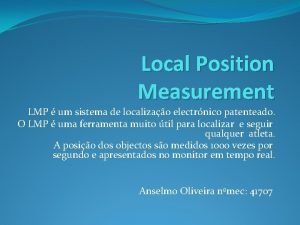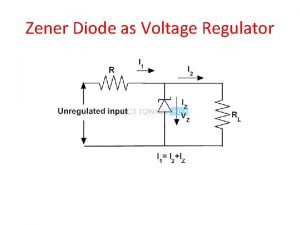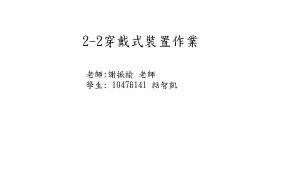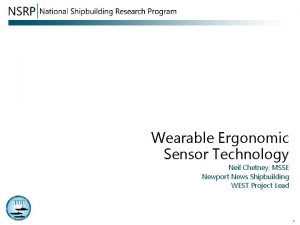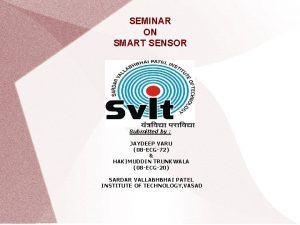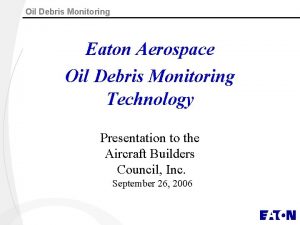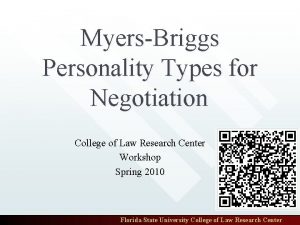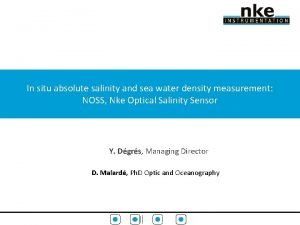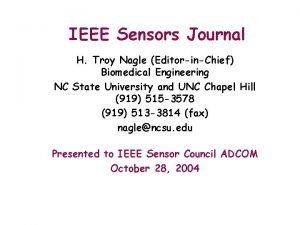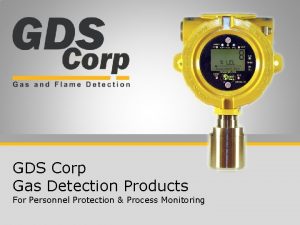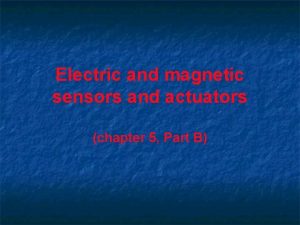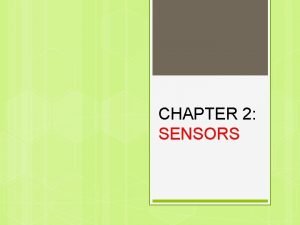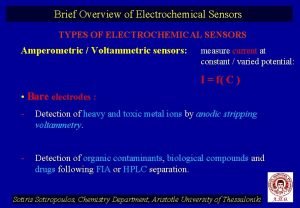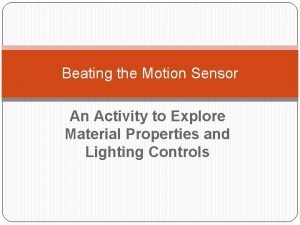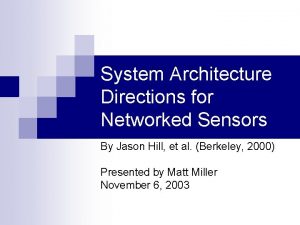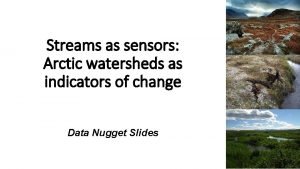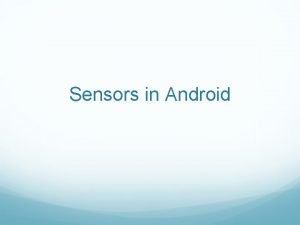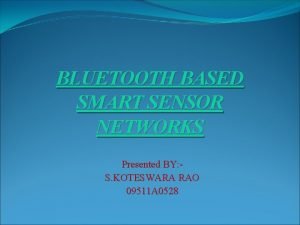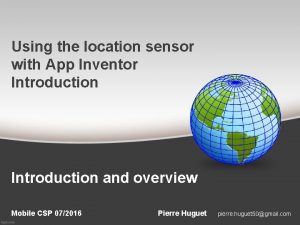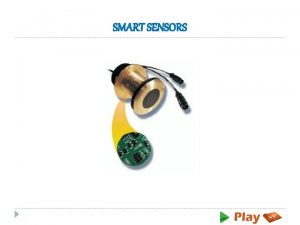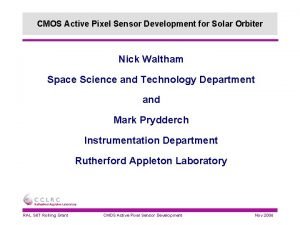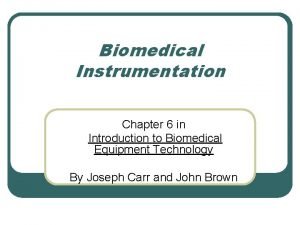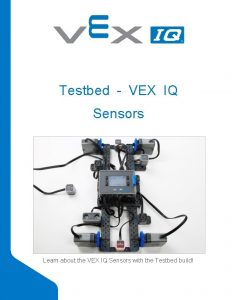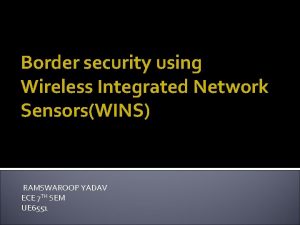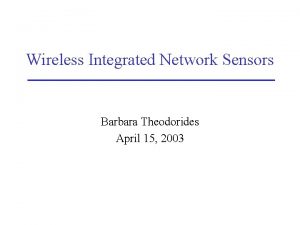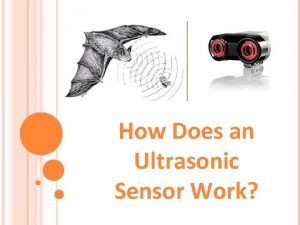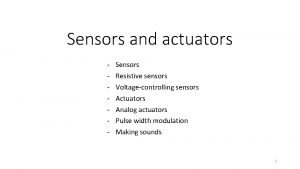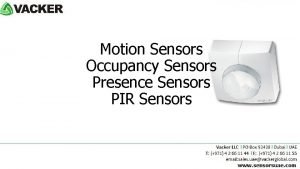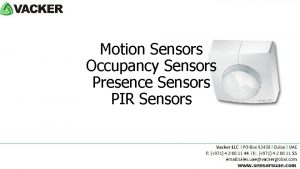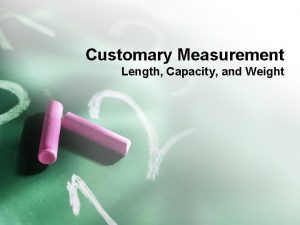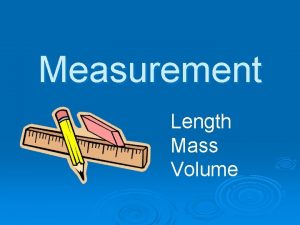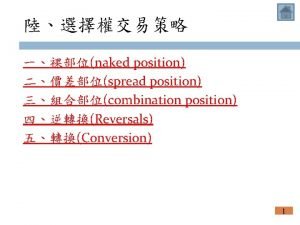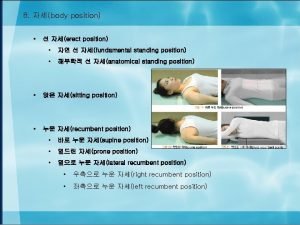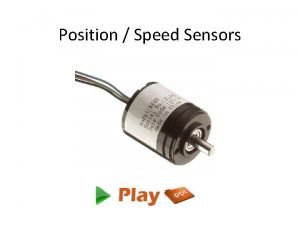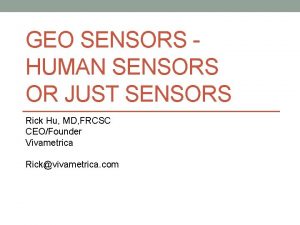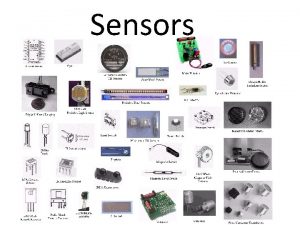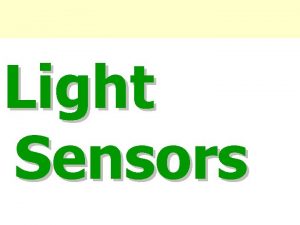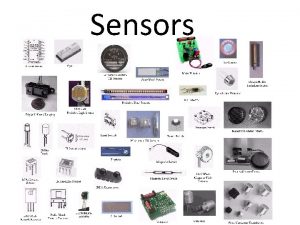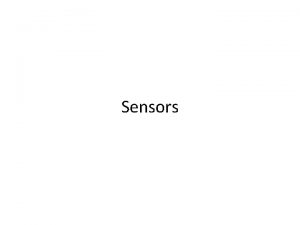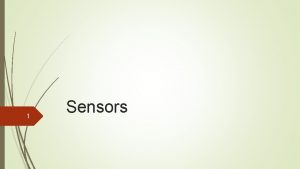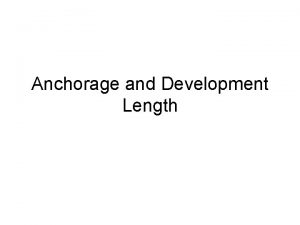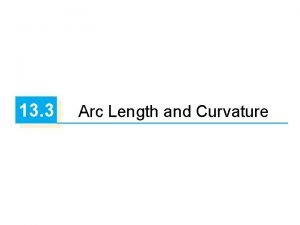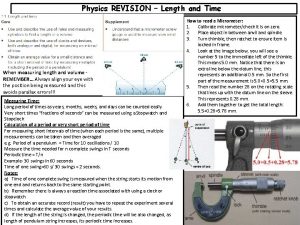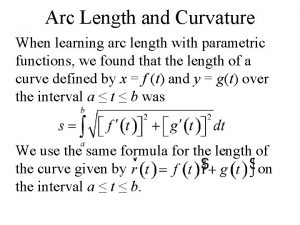POSITION SENSORS ch1 Length measurement Sensors and Measurement



















































- Slides: 51

POSITION SENSORS ch-1 Length measurement Sensors and Measurement Instrumenattion Systems II

Types of position sensors • Sensing presence • Sensing Position ch-1 Length measurement Sensors and Measurement Instrumenattion Systems II

Sensing presence • • Limit switches Photoelectric limit switch Magnetic detection Inductive proximity ch-1 Length measurement Sensors and Measurement Instrumenattion Systems II

• Switches – simplest form of digital displacement sensor • many forms: lever or push-rod operated microswitches; float switches; pressure switches; etc. A limit switch ch-1 Length measurement A float switch Sensors and Measurement Instrumenattion Systems II

• Opto-switches – consist of a light source and a light sensor within a single unit • 2 common forms are the reflective and slotted types A reflective opto-switch ch-1 Length measurement A slotted opto-switch Sensors and Measurement Instrumenattion Systems II

Proximity Sensing: • Proximity detectors are electrical or electronic sensors that respond to the presence of a material ch-1 Length measurement Sensors and Measurement Instrumenattion Systems II

Inductive proximity sensors ____________ – coil inductance is greatly affected by the presence of ferromagnetic materials – here the proximity of a ferromagnetic plate is determined by measuring the inductance of a coil Inductive proximity sensors ch-1 Length measurement Sensors and Measurement Instrumenattion Systems II

ch-1 Length measurement Sensors and Measurement Instrumenattion Systems II

When to Use Mechanical • Where physical contact is possible • Where definitive position is required • In operation-critical or safety-critical situations • Where environment conditions preclude the use of optical or inductive sensors ch-1 Length measurement Sensors and Measurement Instrumenattion Systems II

ch-1 Length measurement Sensors and Measurement Instrumenattion Systems II

• Optical Proximity Sensors Optical Proximity • Consist of a light source (LED)Sensors and light detector • (phototransistor) • Modulation of signal to minimize ambient lighting • conditions • Various models: 12 -30 V DC, 24 -240 V AC, power • Output: TTL 5 V, Solid-state relay, etc. ch-1 Length measurement Sensors and Measurement Instrumenattion Systems II

ch-1 Length measurement Sensors and Measurement Instrumenattion Systems II

When to use an Optical • • Pros – Non-contact, no moving parts, small. – Fast switching, no switch bounce. – Insensitive to vibration and shock – Many configurations available • Cons – Alignment always required – Can be blinded by ambient light conditions (welding for example) • – Requires clean, dust and water free, environment ch-1 Length measurement Sensors and Measurement Instrumenattion Systems II

Application • • Stack height control/box counting Fluid level control (filling and clarity) Breakage and jam detection And many others… ch-1 Length measurement Sensors and Measurement Instrumenattion Systems II

ch-1 Length measurement Sensors and Measurement Instrumenattion Systems II

ch-1 Length measurement Sensors and Measurement Instrumenattion Systems II

When to use Ultrasonic • • Provide range data directly: • Level monitoring of solid and liquids • Approach warning (collisions) • Can (usually) work in heavy dust and water • • Ambient noise is potentially an issue ch-1 Length measurement Sensors and Measurement Instrumenattion Systems II

ch-1 Length measurement Sensors and Measurement Instrumenattion Systems II

• Resistive Position sensors Ø Mechanically varied resistance (potentiometer) Linear and Angular potentiometer Ø Resistivity change (Strain gage) • Capacitive • Inductive LVDT (linear voltage differential transformer) • Reluctance Resolver and Synchro • Piezoelectric • Pulse (encoder) Linear and Rotary encoder ch-1 Length measurement Sensors and Measurement Instrumenattion Systems II

POTENTIOMETERS ch-1 Length measurement Sensors and Measurement Instrumenattion Systems II

Resistive sensor : potentiometer • A potentiometer converts a linear or angular displacement into a corresponding change in ouptut voltage : – Object whose displacement is to be measured is connected Vi to the moving contact l x Vo – Output voltage is linearly related to the displacement, x – DC power • range~l • mechanical wear • Example application : positioning of robotics; e. g. in artificial limbs ch-1 Length measurement Sensors and Measurement Instrumenattion Systems II

Linear Position ch-1 Length measurement Sensors and Measurement Instrumenattion Systems II

Shaft Angle With Potentiometer • shaft angle proportional to voltage Vs • voltage Vs changes because of the change in resistance • simple application of Ohm’s law • current is constant ch-1 Length measurement Sensors and Measurement Instrumenattion Systems II

Angular Displacement - Potentiometer ch-1 Length measurement Sensors and Measurement Instrumenattion Systems II

ch-1 Length measurement Sensors and Measurement Instrumenattion Systems II

POTENTIOMETERS ch-1 Length measurement Sensors and Measurement Instrumenattion Systems II

Resist ivy change : strain gauge • A strain gauge is a displacement sensor whose resistance changes in response to a change in length caused by an applied force Consider a wire with length, l and cross sectional area, A : F A l F – With no force applied : – With an applied force, the length increases by Dl. – Since the total volume of the material remains constant, the change in area is given as : and the change in resistance as : ch-1 Length measurement Sensors and Measurement Instrumenattion Systems II

Resistive sensor : strain gauge • Gauge factor, G, is given as : and may be taken as the sensitivity of the sensor • For metal wire gauges (constantan), G ~ 2, while silicon semiconductor gauges have higher sensitivity, G ~ 200 • Bonded strain gauges have folded wires bonded to a semi flexible backing material, with unbonded gauges having flexible wires connected between fixed and movable frames fixed plate movable plate • a ch-1 Length measurement Sensors and Measurement Instrumenattion Systems II

Strain Gauge • resistance varies with the amount of stretching (strain) • flexure can be measured with a strain gauge • force can also be measured ch-1 Length measurement Sensors and Measurement Instrumenattion Systems II

Bridge circuits • Often the sensitivity of the basic sense element is very low; e. g. a strain gauge may produce a maximum change in resistance of only ~1% over the full operating range. It is important that this change can be accurately detected. • Sensors are often sensitive to more than one quantity; e. g. the resistance of strain gauges depends on both strain and temperature. Therefore, if the temperature of the gauge changes it produces a change in resistance which may be interpreted as a change in strain. • Two and more active sense elements can be used in a bridge circuit to increase the overall sensitivity of the sensor system. ch-1 Length measurement Sensors and Measurement Instrumenattion Systems II

Wheatstone bridge • The basic Wheatstone bridge circuit is shown : – The output voltage is given as : R VB + R 1 2 + by voltage divider on each leg. Vo – The bridge is used in 2 ways – either as a null detector or as a device that reads a difference voltage directly. • For sensor circuits, the difference voltage due to deviation of one or more resistors in the bridge from an initial value is usually measured. R 3 ch-1 Length measurement R 4 Sensors and Measurement Instrumenattion Systems II

Bridge sensor circuits • Sensor bridges normally consist of 4 identical sensor elements. Consider the case when only one of these is sensitive to the quantity to be measured (other sensors are ‘dummy’ sensors) : VB + R R R • R+DR + Vo For example, for a max 1% change in resistance, the output voltage is ~0. 0025 VB; i. e. 2. 5 m. V for a 10 V supply. The range of Vo in this case is 0 – 2. 5 m. V, which can be accurately detected using a voltmeter with FSD of 2. 5 m. V. Consider the alternative of measuring the absolute change in resistance ! ch-1 Length measurement Sensors and Measurement Instrumenattion Systems II

Advantages of bridge circuits • Increased measurement accuracy • Elimination of ‘noise’ effects on sensor output; i. e. if a sensor is sensitive to changes in both temperature and strain, if 4 identical elements are used with only one of them subjected to the strain, the temperature effect is cancelled R R VB + R • Possibility for increased sensitivity : R +DR VB + R ch-1 Length measurement R R+DR + Vo Sensors and Measurement Instrumenattion Systems II R+DR + Vo

Disadvantages of bridge circuits • Linearity error : R +DR VB + R R R+DR + Vo E. g. For maximum DR = 1%, a linearity error of 0. 5% of the FSD output voltage range is calculated. ch-1 Length measurement Sensors and Measurement Instrumenattion Systems II

Zero bridge linearity error • Zero-linearity error is achieved by having pairs of sensors with equal and opposite response characteristics : R–DR R +DR R –DR R VB + R + R+DR V o VB + R –DR R+DR + Vo • Advantages of increased accuracy, increased sensitivity and immunity to noise / temperature are maintained. ch-1 Length measurement Sensors and Measurement Instrumenattion Systems II

Inductive and Capacitive • Inductive sensors use change in local magnetic field to detect presence of metal target • Capacitive Sensors use change in local capacitance caused by non-metallic objects • • Generally short ranges only • • Regarded as very robust and reliable ch-1 Length measurement Sensors and Measurement Instrumenattion Systems II

Inductive and capacitive • inductive: for detection of steel, chrome-nickel, stainless steel, brass, aluminum, copper parts • capacitive: for detection of steel, water, wood, glass, plastics ch-1 Length measurement Sensors and Measurement Instrumenattion Systems II

Capacitive displacement sensor • A capacitive displacement sensor produces an output signal due to the change in capacitance caused by varying the distance between a fixed and a movable plate : A movable plate d fixed plate • Example application : measuring patient respiration rate or patient movement by having several sensors placed underneath them on a bed. ch-1 Length measurement Sensors and Measurement Instrumenattion Systems II

ch-1 Length measurement Sensors and Measurement Instrumenattion Systems II

Inductive displacement sensor (LVDT) I • A linear variable displacement transformer (LVDT) is a 3 coil inductive transducer. – Mutual inductance between the coils is changed as the position + of a high permeability rod is S 1 vout(t) moved between them : + vin(t) P – ferrite rod – + S 2 – – Secondary windings are connected in series opposition – When the rod is centred, equal secondary voltages are induced, s. t. the output voltage is zero Sensors and Measurement ch-1 Length measurement Instrumenattion Systems II

Inductive displacement sensor (LVDT) ch-1 Length measurement Sensors and Measurement Instrumenattion Systems II

Inductive displacement sensor (LVDT) II + + vin(t) P – u u S 1 – + S 2 vout(t) – As the rod moves from the centre, as shown, k 1 increases, while k 2 decreases – vout(t) is linearly related to the change in position of the rod AC voltage source – • range is limited by extent of coils • no moving parts Example application : repetitive displacements in robotics ch-1 Length measurement Sensors and Measurement Instrumenattion Systems II

Linear Variable Displacement Transformer (LVDT) • moving iron core changes properties of transformer • iron core position changes primary/secondary voltage ratio • difference in phase is measured and tranformed to a voltage ch-1 Length measurement Sensors and Measurement Instrumenattion Systems II

• The major categories are: inductive: for detection of steel, chrome-nickel, stainless steel, brass, aluminum, copper parts • capacitive: for detection of steel, water, wood, glass, plastics ch-1 Length measurement Sensors and Measurement Instrumenattion Systems II

Encoder • A device used to convert linear or rotational position information into an electrical output signal. ch-1 Length measurement Sensors and Measurement Instrumenattion Systems II

Absolute position encoders – a pattern of light and dark strips is printed on to a strip and is detected by a sensor that moves along it • the pattern takes the form of a series of lines as shown below • it is arranged so that the combination is unique at each point • sensor is an array of photodiodes ch-1 Length measurement Sensors and Measurement Instrumenattion Systems II

Incremental position encoder – uses a single line that alternates black/white • two slightly offset sensors produce outputs as shown below • detects motion in either direction, pulses are counted to determine absolute position (which must be initially reset) ch-1 Length measurement Sensors and Measurement Instrumenattion Systems II

Other counting techniques • several methods use counting to determine – position two examples are given below • Inductive sensor ch-1 Length measurement Opto-switch sensor Sensors and Measurement Instrumenattion Systems II

ENCODERS ch-1 Length measurement Sensors and Measurement Instrumenattion Systems II

INDUSTRIAL APPLICATIONS of ENCODERS ch-1 Length measurement Sensors and Measurement Instrumenattion Systems II

Reluctance RESOLVERS • A resolver is a rotary transformer that produces an output signal that is a function of the rotor position. ch-1 Length measurement Sensors and Measurement Instrumenattion Systems II
 Balanced dfd
Balanced dfd Balancing in dfd
Balancing in dfd Financial accounting kimmel ch1-2
Financial accounting kimmel ch1-2 Flow ch1
Flow ch1 Tabulka ch1
Tabulka ch1 Tabulka ch1
Tabulka ch1 Second position ballet
Second position ballet What is the ratio of the length of to the length of ?
What is the ratio of the length of to the length of ? Fundamental position definition
Fundamental position definition Fundamental position vs anatomical position
Fundamental position vs anatomical position Mechatronics lecture notes
Mechatronics lecture notes Introduction to sensors and actuators
Introduction to sensors and actuators Sensors and transducers are subsystem of mechatronics.
Sensors and transducers are subsystem of mechatronics. Ajay sensors and instruments
Ajay sensors and instruments Transducer
Transducer Transducer
Transducer Ie 423
Ie 423 Sensors and traceability
Sensors and traceability Lmp position
Lmp position Zener diode equations
Zener diode equations Wearable inertial sensors
Wearable inertial sensors Ergonomic+sensors
Ergonomic+sensors Smart washroom management
Smart washroom management Conclusion of smart sensors
Conclusion of smart sensors Monitor oil debris
Monitor oil debris Sensors vs intuitives
Sensors vs intuitives Peas outline
Peas outline Water density sensors
Water density sensors Ieee sensor journal impact factor
Ieee sensor journal impact factor Gds sensors
Gds sensors Actuator with hall effect sensors
Actuator with hall effect sensors Chemical sensors ppt
Chemical sensors ppt Sensors example
Sensors example Types of electrochemical sensors
Types of electrochemical sensors How to beat motion sensors
How to beat motion sensors Exteroceptive sensors examples
Exteroceptive sensors examples System architecture directions for networked sensors
System architecture directions for networked sensors Data nugget streams as sensors answers
Data nugget streams as sensors answers Motion sensor in android
Motion sensor in android Bluetooth based smart sensor network
Bluetooth based smart sensor network Mit app inventor sensors
Mit app inventor sensors Types of smart sensors
Types of smart sensors Robotics merit badge powerpoint
Robotics merit badge powerpoint Poka program
Poka program Sensor communication style
Sensor communication style Development of solar sensors
Development of solar sensors Ngt the talk chapter 6
Ngt the talk chapter 6 Vex iq testbed
Vex iq testbed Wireless integrated network sensors
Wireless integrated network sensors Wireless integrated network sensors
Wireless integrated network sensors How do ultrasonic sensors work
How do ultrasonic sensors work Firewalls and intrusion detection systems
Firewalls and intrusion detection systems



